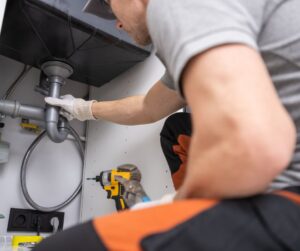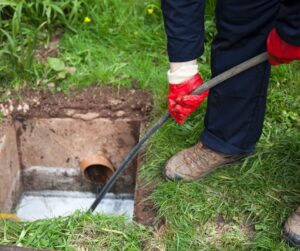Hydro Jetting vs. Snaking
Dealing with a clogged drain can be a frustrating experience for any homeowner. Finding the proper method to clear clogs is essential, whether it’s a slow drain in the kitchen sink or a completely blocked sewer line. Two popular methods for unclogging drains are hydro-jetting and snaking. Both have their advantages and ideal situations for use. In this article, we’ll explore the differences between the hydro-jet and snake and help you decide which method is best for your plumbing needs.
Reach out to Complete Plumbing & Drain for your clogged drain problems and any other plumbing needs.
What is Hydro-Jetting?
Hydro-jetting is a powerful drain cleaning method that uses high-pressure water to clear clogs and clean the interior walls of your plumbing system. During hydro-jetting, a professional plumber inserts a specialized nozzle attached to a high-pressure hose into the clogged drain.
The pressurized water is then blasted through the plumbing system, effectively breaking up and flushing out any debris, grease, or mineral deposits that may be causing the blockage.
Benefits of Using Hydro-Jetting
Thorough Cleaning: Hydro-jetting not only removes clogs but also cleans the entire pipe, preventing future clogs caused by residue buildup.
Effective Against Tough Clogs: This method is particularly effective for clearing stubborn clogs, such as those caused by tree roots, grease, or other hard-to-remove debris.
Environmentally Friendly: Hydro-jetting uses only water, avoiding the need for harsh chemical drain cleaners that can harm the environment and your pipes.
Long-Lasting Results: Hydro-jetting thoroughly cleans the pipe walls, helping prevent future clogs and extending the lifespan of your plumbing system.
Ideal Situations for Hydro-Jetting
- Severe Blockages: Hydro-jetting is often the best solution for severe or recurring clogs that traditional methods like snaking cannot effectively clear.
- Root Infestations: Hydro-jetting is highly effective at removing tree roots infiltrating sewer lines.
- Regular Maintenance: For older plumbing systems or homes with a history of frequent clogs, routine hydro-jetting can help maintain clear pipes and prevent future issues.
- Cleaning Sewer Lines: Hydro-jetting is ideal for thoroughly cleaning large sewer lines, ensuring optimal flow and reducing the risk of backups.

What is Snaking?
Snaking, also known as drain snaking or using a plumber’s snake, is a standard method for clearing clogged drains. The process involves using a long, flexible metal cable with a corkscrew auger at the end. The cable is inserted into the drain, and as it is pushed through the pipe, it dislodges and removes the blockage.
Explanation of the Snaking Process
- Insert the Snake: The plumber inserts the flexible metal cable into the clogged drain, pushing it through the pipes.
- Dislodge the Clog: As the snake moves through the drain, it breaks up the clog, allowing water to flow freely again.
- Retrieve Debris: The snake’s corkscrew auger can also grab and pull out debris causing the blockage.
- Simple and Effective: This method is straightforward and can be very effective for clearing simple clogs in various types of pipes.
Benefits of Using a Drain Snake
Versatility: Drain snakes can be used to remove various types of clogs in kitchen sinks, bathroom drains, and even sewer lines.
Cost-Effective: Snaking is typically less expensive than hydro-jetting, making it a good option for minor clogs.
Quick Solution: This method quickly clears most clogs, allowing you to return to your routine
with minimal disruption.
Less Intrusive: Snaking is less aggressive than hydro-jetting, making it suitable for older pipes that might be damaged by high-pressure water.
Ideal Situations for Snaking
- Minor Clogs: For minor clogs caused by hair, food particles, or small objects, snaking is often the best way to clear the drain.
- Single Fixtures: If only one fixture, like a kitchen sink or shower drain, is clogged, snaking is usually sufficient.
- Initial Attempts: When dealing with a new clog, snaking is often the first method to try before moving on to more aggressive solutions like hydro-jetting.
- Routine Maintenance: Regular snaking can help prevent future clogs by keeping pipes clear of buildup and debris
Hydro-Jetting vs Snake: Key Differences
When it comes to clearing clogged drains, choosing between hydro-jetting and snaking can depend on various factors. Let’s compare these two methods based on their effectiveness, cost, and long-term results.
Comparison of Effectiveness
Both hydro-jetting and snaking are effective methods for clearing clogs, but they work differently and are suitable for different types of blockages.
Snaking is a reliable method for removing simple clogs, such as hair or food particles, in sinks and shower drains. It uses a flexible metal cable to break up and remove debris, making it an excellent choice for minor clogs and routine maintenance.
Hydro-jetting, on the other hand, uses high-pressure water streams to clear out clogs and clean the entire pipe.
This method is highly effective for stubborn blockages, such as grease buildup, mineral deposits, and tree roots in sewer lines. The force of the water scours the pipe walls, removing all debris and leaving the pipe clean, which can prevent future clogs more effectively than snaking.
Comparison of Cost
Cost is a significant factor when deciding between hydro-jetting and snaking. Snaking is generally more cost-effective, especially for minor clogs. The average cost of snaking a drain is typically lower because it requires less specialized equipment and less time to perform.
Hydro-jetting, while more expensive, provides a more thorough cleaning of the pipes. The higher cost is due to the specialized equipment and expertise required to operate the high-pressure water jet safely.
However, the benefits of hydro-jetting can outweigh the higher initial cost, especially for severe or recurring clogs, as it can help avoid frequent repairs and maintenance in the future.
Comparison of Long-Term Results
When considering long-term results, hydro-jetting often proves to be the superior choice. Since it thoroughly cleans the entire pipe, it can more effectively prevent future clogs than snaking.
Hydro-jetting can improve the overall health of your plumbing system and extend the life of your pipes by removing all debris, including grease, mineral deposits, and other buildup.
While effective for clearing immediate blockages, snaking does not provide the same level of deep cleaning.
It removes the clog but does not clean the pipe walls, which means debris can quickly accumulate again, leading to future clogs.
Snaking is a good option for minor clogs and routine maintenance, but hydro-jetting is often the better solution for long-lasting results and severe blockages.
By understanding the critical differences between hydro-jetting and snaking, you can decide which method is best for your plumbing needs. For persistent or severe clogs, consulting with a professional plumber can help determine the most effective approach for your specific situation.

Choosing the Right Method for Your Drain
When deciding between hydro-jetting and snaking to clear a clogged drain, several factors should be considered to ensure you choose the most effective method for your plumbing issue. Here are some key points to keep in mind.
Factors to Consider
Type of Clog: The nature of the clog is a significant factor in choosing the right method. Snaking is often sufficient for simple clogs caused by hair, food particles, or small objects. It’s a straightforward, cost-effective solution that can quickly clear the blockage. However, hydro-jetting is more effective for more severe clogs caused by grease buildup, mineral deposits, or tree roots in sewer lines. The high-pressure water can thoroughly clean the pipes, removing stubborn debris that a snake might miss.
Location of the Clog: The location of the clog within your plumbing system also matters. For clogs in smaller pipes or more accessible locations, snaking is typically easier and faster. However, hydro-jetting can provide a more comprehensive clean for blockages deep within the sewer line or in hard-to-reach areas. The powerful stream of water can travel through the entire pipe, ensuring all debris is removed.
Condition of Your Pipes: The age and condition of your plumbing system should be considered. Older pipes might not withstand the force of hydro-jetting, making snaking a safer option. However, hydro-jetting can be highly effective and safe for newer or more robust plumbing systems. It’s always a good idea to consult with a professional plumber to assess the condition of your pipes before deciding on the method.
Frequency of Clogs: If you experience frequent clogs, hydro-jetting might be the best long-term solution. While snaking can provide a temporary fix, hydro-jetting cleans the entire pipe, helping to prevent future blockages. This can save you time and money on repeated maintenance and repairs.
Common Scenarios and Recommended Methods
Kitchen Sink Clogs: For kitchen sinks clogged with food particles and grease, hydro-jetting is often the best choice. The high-pressure water can effectively break down grease buildup and flush it out of the pipes.
Bathroom Drains: Hair and soap scum are common culprits in bathroom drain clogs. Snaking can usually handle these blockages effectively. However, if the clogs are frequent or severe, hydro-jetting might be necessary to provide a deeper clean.
Sewer Line Blockages: For serious clogs in the sewer line, such as those caused by tree roots or significant debris, hydro-jetting is the recommended method. It can thoroughly clean the entire pipe, removing all obstructions and preventing future issues.
Older Homes: In older homes with aging pipes, snaking is often safer and more appropriate. The lower pressure of a plumbing snake is less likely to damage delicate or corroded pipes.
Choosing the right method for your drain can significantly affect the effectiveness and longevity of the solution. For any plumbing issue, especially persistent or severe clogs, consulting with a professional plumber is the best way to ensure you choose the correct method for your home.
Key Takeaways on Hydro-Jetting vs Snaking
Choosing the proper method to clear your clogged drain is crucial for maintaining a healthy plumbing system. Here’s a quick recap of the key differences between hydro-jetting and snaking:
- Hydro-Jetting: This method uses high-pressure water to thoroughly clean pipes, removing stubborn clogs, grease buildup, and even tree roots. It’s ideal for severe blockages and offers long-term results by preventing future clogs. However, it’s generally more expensive and may not be suitable for older pipes.
- Snaking: This traditional method involves using a flexible metal cable to break up and remove clogs. It’s effective for minor clogs and more accessible locations. Snaking is typically less expensive and less invasive but may not provide the same thorough cleaning as hydro-jetting for severe or deep-seated blockages.
It’s always best to consult with a professional plumber for any persistent or severe plumbing issues.
At Complete Plumbing and Drain, we have extensive experience in dealing with all types of clogs and can help you choose the best method for your specific needs.
Whether you need hydro-jetting, snaking, or routine maintenance, our team is here to ensure your plumbing system runs smoothly.
If you’re experiencing a clogged drain and unsure whether hydro-jetting or snaking is the best solution, contact Complete Plumbing and Drain today. Our professional plumbers are ready to assess your situation and provide the most effective and efficient solution.
Don’t let stubborn clogs disrupt your day – let us help you keep your plumbing system in top shape! Visit our website or give us a call to schedule an appointment.